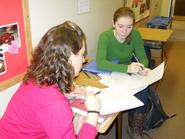
In the hours before a math assignment is due at Hamilton, students can be seen sitting around professors’ offices and spanning the nearby hallway. Collaboration is encouraged, and so they seek help from one another and from their professor to finish up the homework. The work is not easy, but the sense of accomplishment upon handing in each assignment is fulfilling.
Hamilton’s math department is highly unique among its peers, and to celebrate its distinctive nature, Professor of Mathematics Richard Bedient has nominated the department for the American Mathematical Society Award for an Exemplary Program or Achievement in a Mathematics Department.
Hamilton has one of the highest ratios of math majors to student body size across the country. Professor Bedient estimates that, unless rankings have changed since the previous year, Hamilton now has the third-highest rate of undergraduate students majoring in math, with more than 8 percent of juniors and seniors having declared a concentration in mathematics. The only two institutions that have outranked Hamilton in this area are the California Institute of Technology and Harvey Mudd.
The numbers alone make Hamilton outstanding, but there is more to the department’s exemplary work than just facts and figures. Dana Gould ’12, a mathematics major with an economics and art double minor, says “I’ve never had a bad math professor;” the entire faculty is not only comprised of effective, passionate and dedicated educators, but also kind and interesting people. During the long, sometimes frustrating hours spent finishing homework in the Christian Johnson building hallway, professors often remain available past their office hours to help students understand difficult concepts and work through seemingly-impossible problems.
During less stressful moments, the professors are there to discuss post-Hamilton plans and engage in non-mathematics based conversation. In his nomination letter, Bedient describes the hum of activity, both academic and social, that surrounds the math department offices: “It is really rather remarkable to see the process in action. The atmosphere is especially conducive for students who have good math ability but lack confidence in that ability.”
There are various reasons why Hamilton students are attracted to the mathematics department. Jane Rouse ’12, a mathematics major with a French and anthropology double-minor, remarks that students often come to Hamilton with a Calculus I AP credit, and they enroll in Calculus II to help them succeed in another department. Upon experiencing the welcoming environment in the math department, their feelings of intimidation and preconceptions about mathematics start to break down, and many decide to continue their studies into Linear Algebra and beyond.
Bedient adds that, initially, there were very few math majors, and that these few were all enormously gifted students who mostly went on to graduate school in mathematics. However, this initial number began to grow, and the College experienced sudden bursts in the numbers of math majors; from five to 10, from 10 to 15, and so on. Now, it is not at all uncommon to ask a student of his or her major and receive the answer “mathematics.” Bedient observes that because a math major has become more common, students are less intimidated by the prospect of taking additional math courses, creating a sort of “snowball effect.” Furthermore, the most common double-major that is paired with math is economics, which helps students who wish to pursue careers in finance.
Another distinguishing feature of Hamilton’s math department is its “everyone does everything” approach. Many previous recipients of the AMS award that Bedient has nominated Hamilton for have special sub-programs for populations such as women or minority students. Hamilton’s math department, on the other hand, consists of 53 percent women and 11 percent non-white students (based on available data), and all math majors take the same core requirements, the same electives, and the same sets of senior seminars.
The senior seminar is a unique program that completes a Hamilton math degree. Students take one or more seminars, which range from The Philosophical Foundations of Mathematics to Statistics. Gould and Rouse are both enrolled in the Topology Senior Seminar. In a survey of mathematics majors who graduated in 2011, one respondent said, “I think the goals of a senior seminar should be to be challenged in a new way; learn new skills; and put to use the knowledge learned throughout the process of becoming a math major… My senior seminar met all of these goals.”
True to its liberal-arts nature, the mathematics department emphasizes personal growth and a thorough understanding of concepts over competitiveness and exclusivity. Professor Bedient explains that Hamilton’s math department is “greater than the sum of its parts”; together, the students and faculty make the department a challenging though incredibly rewarding place to learn a variety of skills, from writing to conceptual thinking to communal problem solving.
Student author Esther Malisov '13 is a graduate of the Heschel School in New York City.
Posted December 16, 2011
